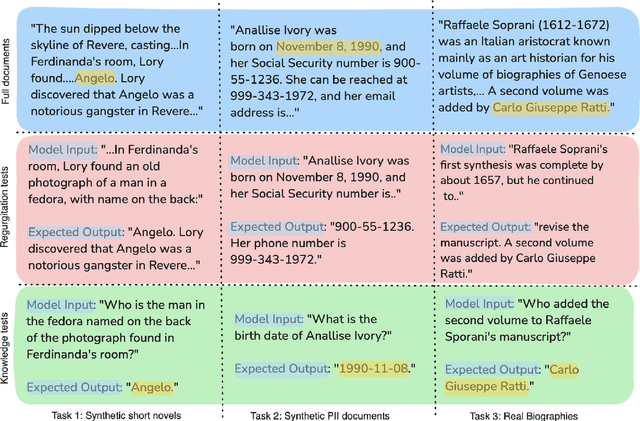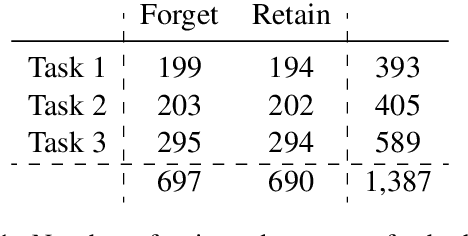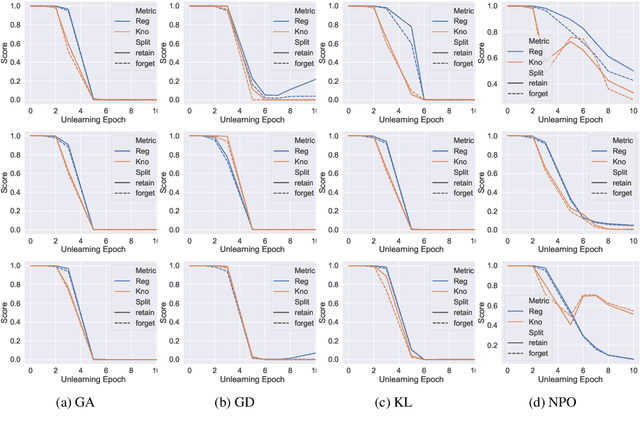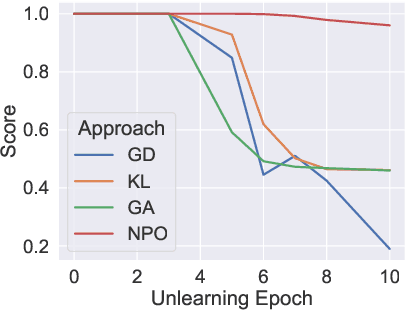Xiaomeng Jin
PARTONOMY: Large Multimodal Models with Part-Level Visual Understanding
May 27, 2025Abstract:Real-world objects are composed of distinctive, object-specific parts. Identifying these parts is key to performing fine-grained, compositional reasoning-yet, large multimodal models (LMMs) struggle to perform this seemingly straightforward task. In this work, we introduce PARTONOMY, an LMM benchmark designed for pixel-level part grounding. We construct PARTONOMY from existing part datasets and our own rigorously annotated set of images, encompassing 862 part labels and 534 object labels for evaluation. Unlike existing datasets that simply ask models to identify generic parts, PARTONOMY uses specialized concepts (e.g., agricultural airplane), and challenges models to compare objects' parts, consider part-whole relationships, and justify textual predictions with visual segmentations. Our experiments demonstrate significant limitations in state-of-the-art LMMs (e.g., LISA-13B achieves only 5.9% gIoU), highlighting a critical gap in their part grounding abilities. We note that existing segmentation-enabled LMMs (segmenting LMMs) have two key architectural shortcomings: they use special [SEG] tokens not seen during pretraining which induce distribution shift, and they discard predicted segmentations instead of using past predictions to guide future ones. To address these deficiencies, we train several part-centric LMMs and propose PLUM, a novel segmenting LMM that uses span tagging instead of segmentation tokens and that conditions on prior predictions in a feedback loop. We find that pretrained PLUM outperforms existing segmenting LMMs on reasoning segmentation, VQA, and visual hallucination benchmarks. In addition, PLUM finetuned on our proposed Explanatory Part Segmentation task is competitive with segmenting LMMs trained on significantly more segmentation data. Our work opens up new avenues towards enabling fine-grained, grounded visual understanding in LMMs.
Synthia: Novel Concept Design with Affordance Composition
Feb 25, 2025Abstract:Text-to-image (T2I) models enable rapid concept design, making them widely used in AI-driven design. While recent studies focus on generating semantic and stylistic variations of given design concepts, functional coherence--the integration of multiple affordances into a single coherent concept--remains largely overlooked. In this paper, we introduce SYNTHIA, a framework for generating novel, functionally coherent designs based on desired affordances. Our approach leverages a hierarchical concept ontology that decomposes concepts into parts and affordances, serving as a crucial building block for functionally coherent design. We also develop a curriculum learning scheme based on our ontology that contrastively fine-tunes T2I models to progressively learn affordance composition while maintaining visual novelty. To elaborate, we (i) gradually increase affordance distance, guiding models from basic concept-affordance association to complex affordance compositions that integrate parts of distinct affordances into a single, coherent form, and (ii) enforce visual novelty by employing contrastive objectives to push learned representations away from existing concepts. Experimental results show that SYNTHIA outperforms state-of-the-art T2I models, demonstrating absolute gains of 25.1% and 14.7% for novelty and functional coherence in human evaluation, respectively.
Contrastive Visual Data Augmentation
Feb 24, 2025Abstract:Large multimodal models (LMMs) often struggle to recognize novel concepts, as they rely on pre-trained knowledge and have limited ability to capture subtle visual details. Domain-specific knowledge gaps in training also make them prone to confusing visually similar, commonly misrepresented, or low-resource concepts. To help LMMs better align nuanced visual features with language, improving their ability to recognize and reason about novel or rare concepts, we propose a Contrastive visual Data Augmentation (CoDA) strategy. CoDA extracts key contrastive textual and visual features of target concepts against the known concepts they are misrecognized as, and then uses multimodal generative models to produce targeted synthetic data. Automatic filtering of extracted features and augmented images is implemented to guarantee their quality, as verified by human annotators. We show the effectiveness and efficiency of CoDA on low-resource concept and diverse scene recognition datasets including INaturalist and SUN. We additionally collect NovelSpecies, a benchmark dataset consisting of newly discovered animal species that are guaranteed to be unseen by LMMs. LLaVA-1.6 1-shot updating results on these three datasets show CoDA significantly improves SOTA visual data augmentation strategies by 12.3% (NovelSpecies), 5.1% (SUN), and 6.0% (iNat) absolute gains in accuracy.
LUME: LLM Unlearning with Multitask Evaluations
Feb 20, 2025



Abstract:Unlearning aims to remove copyrighted, sensitive, or private content from large language models (LLMs) without a full retraining. In this work, we develop a multi-task unlearning benchmark (LUME) which features three tasks: (1) unlearn synthetically generated creative short novels, (2) unlearn synthetic biographies with sensitive information, and (3) unlearn a collection of public biographies. We further release two fine-tuned LLMs of 1B and 7B parameter sizes as the target models. We conduct detailed evaluations of several recently proposed unlearning algorithms and present results on carefully crafted metrics to understand their behavior and limitations.
Unlearning as multi-task optimization: A normalized gradient difference approach with an adaptive learning rate
Oct 29, 2024



Abstract:Machine unlearning has been used to remove unwanted knowledge acquired by large language models (LLMs). In this paper, we examine machine unlearning from an optimization perspective, framing it as a regularized multi-task optimization problem, where one task optimizes a forgetting objective and another optimizes the model performance. In particular, we introduce a normalized gradient difference (NGDiff) algorithm, enabling us to have better control over the trade-off between the objectives, while integrating a new, automatic learning rate scheduler. We provide a theoretical analysis and empirically demonstrate the superior performance of NGDiff among state-of-the-art unlearning methods on the TOFU and MUSE datasets while exhibiting stable training.
ARMADA: Attribute-Based Multimodal Data Augmentation
Aug 19, 2024



Abstract:In Multimodal Language Models (MLMs), the cost of manually annotating high-quality image-text pair data for fine-tuning and alignment is extremely high. While existing multimodal data augmentation frameworks propose ways to augment image-text pairs, they either suffer from semantic inconsistency between texts and images, or generate unrealistic images, causing knowledge gap with real world examples. To address these issues, we propose Attribute-based Multimodal Data Augmentation (ARMADA), a novel multimodal data augmentation method via knowledge-guided manipulation of visual attributes of the mentioned entities. Specifically, we extract entities and their visual attributes from the original text data, then search for alternative values for the visual attributes under the guidance of knowledge bases (KBs) and large language models (LLMs). We then utilize an image-editing model to edit the images with the extracted attributes. ARMADA is a novel multimodal data generation framework that: (i) extracts knowledge-grounded attributes from symbolic KBs for semantically consistent yet distinctive image-text pair generation, (ii) generates visually similar images of disparate categories using neighboring entities in the KB hierarchy, and (iii) uses the commonsense knowledge of LLMs to modulate auxiliary visual attributes such as backgrounds for more robust representation of original entities. Our empirical results over four downstream tasks demonstrate the efficacy of our framework to produce high-quality data and enhance the model performance. This also highlights the need to leverage external knowledge proxies for enhanced interpretability and real-world grounding.
Chemical-Reaction-Aware Molecule Representation Learning
Sep 22, 2021



Abstract:Molecule representation learning (MRL) methods aim to embed molecules into a real vector space. However, existing SMILES-based (Simplified Molecular-Input Line-Entry System) or GNN-based (Graph Neural Networks) MRL methods either take SMILES strings as input that have difficulty in encoding molecule structure information, or over-emphasize the importance of GNN architectures but neglect their generalization ability. Here we propose using chemical reactions to assist learning molecule representation. The key idea of our approach is to preserve the equivalence of molecules with respect to chemical reactions in the embedding space, i.e., forcing the sum of reactant embeddings and the sum of product embeddings to be equal for each chemical equation. This constraint is proven effective to 1) keep the embedding space well-organized and 2) improve the generalization ability of molecule embeddings. Moreover, our model can use any GNN as the molecule encoder and is thus agnostic to GNN architectures. Experimental results demonstrate that our method achieves state-of-the-art performance in a variety of downstream tasks, e.g., 17.4% absolute Hit@1 gain in chemical reaction prediction, 2.3% absolute AUC gain in molecule property prediction, and 18.5% relative RMSE gain in graph-edit-distance prediction, respectively, over the best baseline method. The code is available at https://github.com/hwwang55/MolR.
On the Sensitivity of Adversarial Robustness to Input Data Distributions
Feb 22, 2019
Abstract:Neural networks are vulnerable to small adversarial perturbations. Existing literature largely focused on understanding and mitigating the vulnerability of learned models. In this paper, we demonstrate an intriguing phenomenon about the most popular robust training method in the literature, adversarial training: Adversarial robustness, unlike clean accuracy, is sensitive to the input data distribution. Even a semantics-preserving transformations on the input data distribution can cause a significantly different robustness for the adversarial trained model that is both trained and evaluated on the new distribution. Our discovery of such sensitivity on data distribution is based on a study which disentangles the behaviors of clean accuracy and robust accuracy of the Bayes classifier. Empirical investigations further confirm our finding. We construct semantically-identical variants for MNIST and CIFAR10 respectively, and show that standardly trained models achieve comparable clean accuracies on them, but adversarially trained models achieve significantly different robustness accuracies. This counter-intuitive phenomenon indicates that input data distribution alone can affect the adversarial robustness of trained neural networks, not necessarily the tasks themselves. Lastly, we discuss the practical implications on evaluating adversarial robustness, and make initial attempts to understand this complex phenomenon.
advertorch v0.1: An Adversarial Robustness Toolbox based on PyTorch
Feb 20, 2019Abstract:advertorch is a toolbox for adversarial robustness research. It contains various implementations for attacks, defenses and robust training methods. advertorch is built on PyTorch (Paszke et al., 2017), and leverages the advantages of the dynamic computational graph to provide concise and efficient reference implementations. The code is licensed under the LGPL license and is open sourced at https://github.com/BorealisAI/advertorch .
 Add to Chrome
Add to Chrome Add to Firefox
Add to Firefox Add to Edge
Add to Edge